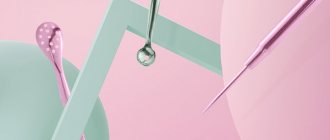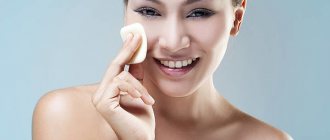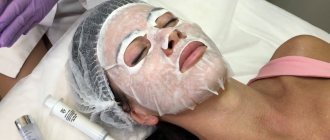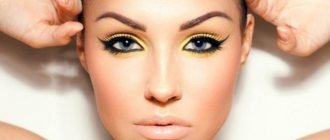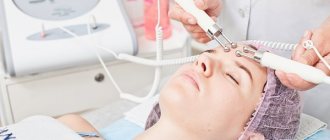Do you know what sebum is? This sebum, which is produced by the sebaceous glands, serves as a reliable natural protection for the skin and hair from any negative external factor. Sebum is the main source of lipids for the superficial protective mantle of the skin, which nature gave to man from the generosity of her soul, so that he could calmly adapt to any environmental conditions.
True, you know, it’s hard to say whether sebum plays a more important role for skin or hair. Without it, normal life would be simply impossible: the sun, background radiation, and poor ecology would constantly drive our skin and curls crazy. Therefore, thanks to sebum and its capabilities, that is, the composition of sebum.
In this article:
What does sebum consist of? Causes of hyper- and hyposecretion of the sebaceous glandsSebum regulation
Sebum - what is it?
Sebum
is a secret consisting of natural esters and fatty acids secreted by the sebaceous glands of the skin. Its main task is to maintain the integrity of the protective hydrolipidic mantle of the epidermis. Simply put, sebum acts as a natural lubricant for the skin.
The most overactive sebaceous glands are in seborrheic areas: the face, upper chest and back. On average, the sebaceous ducts of an adult produce up to 20 g of sebum per day. If for some reason the glands synthesize more sebum than required, a characteristic oily sheen appears on the surface of the facial skin.
Functions of sebum
In addition to the troubles in the form of signs of acne, which are provoked by excess sebum, the secretion also has a number of important functions:
- Natural skin hydration, preventing moisture evaporation from the surface of the epidermis and preventing dryness, dehydration and early skin aging.
- Protection from the negative effects of external factors, such as dust and ultraviolet radiation - sebum acts as a natural antioxidant.
- Antimicrobial protection against pathogenic microflora and maintenance of normal skin microbiome.
- Responsible for the pH balance of the skin.
- Participates in the skin thermoregulation system.
Composition of sebum
Sebum consists of a mixture of various lipids and by its nature cannot harm the skin. The composition of sebum depends on age, gender, lifestyle and genetic characteristics of the body - hormonal levels and the state of the central nervous system and ANS (central and autonomic nervous system). Normally, the secret contains the following components:
- triglycerides (41%);
- wax esters/wax esters (26%);
- squalene (12%);
- fatty acid;
- cholesterol;
- phospholipids;
- glycerol.
Causes of excess sebum production
The main cause of oily skin is testosterone .
Testosterone stimulates the sebaceous glands. When hormonal surges occur, it is produced in larger quantities, which provokes an increased release of sebum.
The main physiological surges of hormones occur when:
- Puberty
- Pregnancy
- Taking oral contraceptives
- Menopause
However, outside of these conditions, an increase in sebum production may be a marker of changes in hormonal levels due to an endocrinological disease . Which will require a visit to an endocrinologist for consultation and assessment of hormonal levels.
Provoking factors for testosterone release are also:
- Stress, emotional disturbances, depressive states
- Professional sports
- Physical fatigue
The second reason is exposure to external factors that provoke dehydration, loss of necessary skin protection and, as a protective reaction, the release of sebum.
- Prolonged exposure to the sun, climate change
Activation of the sebaceous glands of the facial skin is another protective mechanism of the skin, in addition to the formation of a tan, from the harmful effects of UV rays.
- Illiterate care and performing aggressive procedures without further adequate skin care.
In this case, the release of sebum is a protective reaction to skin injury. If rich care products are not used, the skin itself forms a protective sebaceous film on its surface, which makes it oily and shiny.
- Disturbances in nutrition and gastrointestinal tract function
Spicy, salty foods and alcohol activate the sebaceous glands of the facial skin. A number of studies have shown a high correlation between milk consumption and the appearance of oily skin and acne on the face.
The main causes of sebum production disorders
Alexander Prokofiev, a dermatovenereologist and expert of the La Roche-Posay brand, talks about the possible causes of impaired sebum synthesis.
When sebum production increases
- Peak activity of the sebaceous glands occurs during puberty and can last up to 25 years. This is due to hormonal changes in the body. Increased sebum production occurs during pregnancy, certain diseases (endocrine system, liver disease, gastrointestinal imbalance), as well as stress and lack of sleep, as a result of which the body releases the stress hormone cortisol.
- An unbalanced diet, consumption of fatty, salty, or smoked foods, lack of nutrients and fiber stimulate sebum production.
- Lack of cleansing or over-cleansing, overuse of products containing alcohol, as well as certain ingredients in skincare products can all cause clogged pores.
- Often people with signs of a problematic skin type try to cope with excess oiliness on their own and overdo it with mattifying products, thereby drying out the skin. In response to dehydration, the epidermis reacts by releasing a natural moisturizer - sebum, and the face shines even more.
When there is too little sebum
Lack of sebum is the other side of the coin, which in its own way aggravates the condition of the epidermis: dryness, a feeling of tightness, irritation, and peeling appear. Due to a deficiency of lipid-containing secretions, the protective mantle becomes thinner, the epidermis is subject to increased susceptibility to external aggressors, and begins to rapidly lose moisture, elasticity and density. Dry skin is the main reason for the appearance of the first age-related skin changes: wrinkles, decreased turgor.
When sebum is thick
Thick sebaceous secretion is the cause of enlarged pores, comedones and acne. Sebum literally bursts the sebaceous ducts from the inside, forming a sebaceous plug and clogging the pores. Upon contact with oxygen and light, the secretion acquires a characteristic black or dark gray color - this is how sebaceous threads are formed - the well-known black dots.
Why does excess sebum appear?
Excessive activity of the sebaceous glands, responsible for the production of sebum, manifests itself during puberty, as well as during the period of 24-25 years. However, there are other periods during which sebum is especially secreted.
During pregnancy, stressful situations, disruptions in the endocrine system, and infectious diseases, sebum is abundantly secreted. Of course, in the summer, the sebaceous glands also work actively, trying to establish thermoregulation of the skin and retain moisture in the epidermis.
Excess sebum
Signs indicating excess sebum production:
- constant secretion of sebum on the surface of the skin;
- enlarged pores;
- formation of acne and inflammatory lesions.
Consequences of excess sebum secretion
In addition to the obvious consequences in the form of rashes, excessive sebum production entails the following consequences:
- The skin of the face and body becomes shiny, looks unkempt, porous, gets dirty faster, and the image loses its freshness. Some time after the last cleansing of the skin, the oily sheen appears again. By neglecting or, conversely, being too carried away with cleansing, those with oily skin types risk experiencing signs of acne or dehydration of the skin.
- The scalp may also react to increased sebum production: signs of dandruff – oily seborrhea – appear. Against the background of changes in the functioning of the sebaceous glands, too much sebum is produced. At the same time, the skin of the scalp quickly becomes oily, undergoes inflammatory processes and flakes off.
What does sebum contain?
Sebum does not contain anything bad in its composition. The composition of sebum is represented by a variety of lipids. The latter, in turn, are represented by fat-like substances, which are part of all living cells and play an important role in vital processes. The composition of lipids may change with age, and it depends on sex and gender characteristics. But they must include:
- saturated fatty acids, represented by stearic, oleic, palmitic acids;
- squalene;
- sapienate and seboletan (fatty acids of unique origin, contained exclusively in sebum);
- unsaturated fatty acids, represented by acetic, formic, propionic and other acids;
- glycerol;
- wax ether;
- phospholipids;
- cholesterol;
- metabolic product.
Composition of sebum
Sebum control: how to remove excess sebum
Home corrective care based on mattifying formulas that absorb sebum will help control excess sebaceous secretions. In cosmetics for oily problem skin, look for mattifying, moisturizing and restoring components, hydroacids, hydrofixatives, amino acids and antioxidants.
Important: If, after self-care, oily shine and imperfections do not go away, consult a dermatologist. The specialist will prescribe tests, based on the results of which he will adjust your individual sebum removal system.
Alexander Prokofiev, dermatovenereologist, La Roche-Posay brand expert, tells what proper care for oily skin should be to control sebum:
- Any beauty routine begins with regular cleansing. Oily skin requires special attention. Choose non-comedogenic formulas with a mattifying effect.
- Exfoliate the stratum corneum regularly - dead cells mix with sebum and clog pores. Use gentle skin renewal products (scrubs, peelings, gomages) based on exfoliating ingredients, such as AHA, LHA and salicylic acids, 1-2 times a week.
- Products containing different types of clays and their derivatives have an additional cleansing and mattifying effect. For example, Masks absorb excess sebum well, attracting various impurities, thereby cleansing and ridding the skin of blackheads. Apply the mask 1-2 times a week, the next step after intensive cleansing.
- Finish cleansing your skin by applying a mattifying lotion or toner. Give preference to products that do not dry out the skin. The lotion will also prepare the skin for basic care.
- Basic corrective care should be aimed at additional regulation of skin oiliness, have protective, restorative properties and maintain skin hydration, preventing transepidermal moisture loss. As part of corrective care, pay attention to hygroscopic components, such as glycerin and hyaluronic acid.
- Use Sanskrin - UVA and UVB rays disrupt the protective barrier of the epidermis, provoke active sebum production and discomfort.
How to get rid of oily skin on your face
It is possible to get rid of oily skin not only with the help of a professional cosmetologist, but also on your own. To do this, you need to tone your skin every morning with tonics and lotions.
You can prepare a solution from water with various ingredients. That is, this is water plus:
- honey - 2 tablespoons per glass of water;
- aloe - one spoon of juice per glass of water;
- cucumber - cut half a cucumber into circles for 200 g of water.
Leave honey, cucumber or aloe water overnight, and in the morning wipe your face with cotton pads soaked in one of these lotions.
Ordinary green tea without sugar works well to remove oily shine. You can add a couple of drops of tea tree oil.
The method of wiping the face with ice is also popular. Make ice cubes from a decoction of chamomile or calendula and wipe your face with massaging movements in the morning.
Masks based on milk, yogurt, kefir, cucumber, lemon or fruit are also very effective for oily skin.
Having chosen one recipe for yourself, you should regularly do this procedure for 1-2 months. Then, to avoid addiction, change the mask recipe.
TOP 6 La Roche-Posay products to reduce oiliness on the face
Cleansing
Effaclar Ultra micellar water can handle the task of delicately cleansing oily skin without water. Micelles instantly absorb sebum, makeup residues and remove external impurities. The combination of glycerin and zinc derivative mattifies and at the same time protects the skin from dehydration.
EFFACLAR MICELLAR WATER ULTRA
Cleansing for oily problem skin
Thoroughly cleanses the skin of impurities without water. Removes makeup from the face and skin around the eyes. Reduces oily shine, mattifies.
512 rub. more details
For washing, a foaming cleansing gel for oily skin from the Effaclar range is suitable. Gently cleanses the skin and does not leave the skin feeling dry. For oily skin that has become dry due to drug treatment, choose the Effaclar H cleansing cream-gel. It restores comfort to the skin, significantly softens, restores, and soothes.
EFFACLAR GEL
Cleansing foaming gel for oily skin
Cleanses skin and pores of impurities. Removes excess sebum. Does not contain ethyl alcohol, dyes and parabens.
980 rub. more details
EFFACLAR H CLEANSING CREAM-GEL
Cleansing cream-gel for problematic dry skin
Cleanses and moisturizes oily skin. Restores the hydrolipid mantle. It has a sebum-regulating and antibacterial effect.
1385 rub. more details
The second stage of cleansing oily skin is toning - Effaclar pore tightening lotion provides a feeling of clean, fresh and matte skin. Visibly shrinks and further cleanses pores.
EFFACLAR LOTION
Facial lotion to tighten pores
Effectively cleanses pores. Helps reduce pore size. Mattifies.
1512 rub. more details
Use the Effaclar mattifying mask regularly (1-2 times a week) to effectively cleanse pores and control oily shine.
EFFACLAR MASK
Purifying mattifying mask for oily problem skin
Cleans even impurities invisible to the eye. Visibly reduces pores and mattifies the skin.
1167 rub. more details
Facial care rules
With proper facial care, you can protect your skin from various problems.
- To avoid contamination and infection of the skin, you need to protect it before going outside by applying a thin layer of cream.
- It is necessary to moisturize your skin more often and not be afraid that this will increase shine. The amount of sebum production does not depend on the degree of skin hydration.
- Foundation and powder heavily clog pores, so you should not overuse them.
- Try to always have clean handkerchiefs available. However, do not wipe the entire face, but only blot problem areas. This is the nose and forehead.
- For daily use, choose a cosmetic product with a neutral hydrogen level (pH).
- Contact your face as little as possible during the day.
- Avoid using creams that are oily and contain glycerin.
- Visit a cosmetologist at least once a month.
- Do not squeeze out blackheads or pimples yourself, leaving this work to cosmetologists.
If you carefully follow these simple rules, you can prevent problems with your facial skin and also save a lot of money. Now you know that sebum is sebum.
What affects the composition of sebum?
With acne, the secretion of the sebaceous glands may change12:
- the level of free fatty acids with a long carbon chain increases;
- the amount of epidermal lipids decreases;
- the level of linoleic acid decreases.
This leads to increased sebum viscosity, disruption of keratinization processes, and increased colonization of bacteria in the SVF. As a result, the formation of comedones and the subsequent launch of the inflammatory process. 12
Due to the fact that the concentration of linoleic acid in sebum decreases, the pH level also changes - alkalization occurs. This leads to disruption of the barrier function of the skin, the permeability of the follicle epithelium increases, which contributes to the further proliferation of P. Acnes. 12
The consequence of a decrease in linoleic acid in sebum is that proliferation and dyskeratosis prevail over exfoliation of the epithelium, which becomes the cause of follicular hyperkeratosis. 12
How to reduce sebum production
Let us immediately note that if the problem of excessive sebum secretion worries you greatly, then you should make an appointment with a specialist for help. He will send you for tests, and then prescribe systemic and local medications. It has been proven that zinc, salicylic acid and pyruvic acid have sebum-regulating properties.
Perfect for home care:
- mattifying cream and lotion;
- sunscreen for problem skin;
- matting napkins;
- clay masks for oily skin;
- gentle scrub;
- fruit peeling.
A specialist can recommend other personal care products, as well as special preparations to maintain healthy skin and the body as a whole, and you will also find a lot of useful information for use in the sections of the site.


